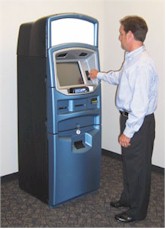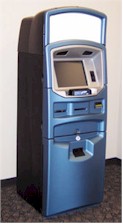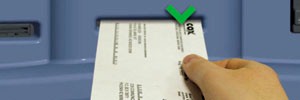News
Make it your own
April 30, 2004
A growing kiosk presence in many areas of consumer life illustrates that self-service is evolving into preferred service for both customers and retailers. Grocery stores, with self-check-out lanes; airports, featuring self-check-in kiosks; gas stations, accepting payment at the pump; and retail stores, with price-check kiosks and gift registries are leading the shift from "how can we help you?" to "how can customers help themselves?" Kiosks in these environments automate administrative and payment-related processes previously handled by cashiers and customer service representatives (CSRs). As customization carves out a market among self-service kiosk providers, the demand for companies that specialize in, "making it your own" rises.
For the consumer, it's about making the transaction their own and the perceived control over its outcome. For Atlanta-based Cox Communications, self-service kiosks are about making the customer's experience unique and maximizing the overall operational value that self-service kiosks offer. Cox Communications, the fourth largest cable provider in the nation, uses kiosks in its stores to accept payments. These kiosks sit in the lobby of Cox's stores and payment centers, targeting those customers who are only making payments. Self-service kiosks benefit Cox in terms of overall savings of time and money, improved customer service and increased opportunities to cross-sell and address service needs.
"As in most traditional services centers, our CSRs handle multiple payment types. Typically, half the people in the lobby are trying to make payments and avoid having their cable turned off at the end of the month. The goal is to get those customers out of line and focus employees on selling new products or trouble shooting for those people with service needs. Cox invests a great deal of time in payment collections, and kiosks help reduce the distractions created by processing payments," said Bruce Beeco, manager Web services and kiosks, Cox Communications.
"Self-service Kiosks help Cox manage a variety of needs, and reducing wait times keeps both employees and customers happy. Payment collections is part of the monthly cycle, but employees shouldn't spend the majority of their time on that, with so many alternatives to payment processing," said Beeco
Self-Service Kiosks also help Cox save money by enabling 24-hour payment capabilities. The after-hours kiosk records and reports late payments into Cox's accounting system, long after the store has closed. When a customer's cable is turned off, Cox schedules a truck to go to the customer's home and unhook the connection. Because the 24-hour payment center collects last minute payments after hours, the service department can automatically cancel a "truck roll" scheduled for the following day. Even if a payment is late, if it comes in before the truck roll, the system reports it and saves Cox time and money.
By helping customers help themselves, companies are free to do more with less. And, in a world of increasing consumer expectations, customization is one of the more efficient and creative ways to differentiate and improve the customer experience, while increasing operational efficiencies.
Customer meets customization
 |
Kiosks may have started off as "one size fits all" but IT executives today are making investment decisions based on how tailored the solutions are to their industry and company-specific needs, as well as future flexibility. In other words, will they have to trash it and redesign the product in a year?
After evaluating a variety of kiosk vendors, Cox selected Charlotte, N.C.-based Source Technologies as its provider. Beeco explains that the decision to bring Source Technologies on board was based on Cox's positive experience with the company's (MICR) printer products.
"We knew about their customized kiosk products, and said, 'let's give these guys a chance.' They were eager to get started on the design."
Beginning in December 2002, Cox piloted a first generation (standard) kiosk, which helped the company realize that a more customized machine could better meet customer and corporate needs. A year later, in March 2003, Cox deployed the remaining first generation kiosks. Feedback from those sites and results from examining customer behavior helped the two companies understand the specific changes needed in the first generation kiosks.
 |
Cox executives were looking to empower the customer and improve the bottom line with a combined approach to in-store planning that incorporated the kiosk as a central component of store layout and improved its functionality.
"We needed to customize the kiosk to better suit the type of payments we accept, and branding, usability, total housing and attractiveness were key issues," added Beeco. "As we built new stores and payment centers, we wanted to design kiosks into the flow, making them a central component of the centers' design and increasing the 24-hour payment capabilities."
The challenge was to make the kiosk "look like Cox" and address critical design elements. Source created a smaller footprint (requiring less floor space), improved accessibility (allowing 24-hour customer and maintenance access), and made the kiosk easier to use (taking the customer's triangle of focus into consideration).
Some of the biggest development issues were device placement, coming up with a style that worked with limited store space, and the "triangle of focus," placing all components (i.e. receipt dispenser and cash acceptor) in the users' line of sight. Ease of access was also crucial for performing day-to-day maintenance such as changing paper. The design needed to be sleek, with rear access to the wall and a quality sound system.
Source Technologies created a design that met all of these issues and carefully selected its vendor partner, Mount Laurel, N.J.-based, Productive Plastics, based on their expertise in developing specialized kiosk encasing.
In January 2004, Cox deployed 16 of the kiosks and is currently on track to deploy approximately 15 to 20 more this year.
 |
No longer "One Size Fits All"
With the kiosk, Cox customers have the option of presenting cash payments, using the cash acceptor; check debits, through a check scanner; and credit cards, with a credit card reader. A barcode scanner identifies customers by reading customer account numbers on bills. The new design also incorporated a high-quality speaker system for audio feedback and instructions.
"Unfortunately, people don't want to read, and, as a result, audio has become a critical element in kiosk design," added Beeco.
Rear access to the kiosk was incorporated for wall mounting and servicing capabilities, such as taking out cash or retrieving data. Cox also connected the kiosk with its network through the program application it developed for the system.
The kiosk design incorporates three components including a top, middle and bottom, all of which are adaptable for additional devise installation. For example, future needs may require a full keyboard as opposed to just a numerical keypad or touchscreen.
The kiosk is modulized for road-mapping future needs and making changes quickly. Cox wanted the flexibility to create new versions of its software application, such as providing the capability to take orders, and quickly adjust the device sections to match. The kiosks they use today, won't be the same kiosk down the road.
As customer demands and expectations continue rising, retailers need alternative solutions that keep pace with consumer demands. With more companies like Cox adapting its stores and its approach to service to meet the individual needs of a variety of customer types, consumers will be empowered to take control over their own in-store transactions. First generation kiosks no longer satisfy the consumer whose mind is already one step ahead of the current technology offered in self-service environments. Forward thinking and custom designs will help merchants take control of the customer's self-help experience and set them apart from those companies that take the "one size fits all" approach to service.
Researchwww.cox.com www.sourcetech.com www.productiveplastics.com
Originally published in the May/Jun 2004 issue ofKiosk magazine.







